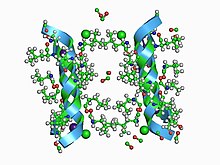
In electrophysiology, the term gating refers to the opening (activation) or closing (by deactivation or inactivation) of ion channels.[1] This change in conformation is a response to changes in transmembrane voltage.[2]
When ion channels are in a 'closed' (non-conducting) state, they are impermeable to ions and do not conduct electrical current. When ion channels are in their open state, they conduct electrical current by allowing specific types of ions to pass through them, and thus, across the plasma membrane of the cell. Gating is the process by which an ion channel transitions between its open and closed states.[3]
A variety of cellular changes can trigger gating, depending on the ion channel, including changes in voltage across the cell membrane (voltage-gated ion channels), chemicals interacting with the ion channel (ligand-gated ion channels), changes in temperature,[4] stretching or deformation of the cell membrane, addition of a phosphate group to the ion channel (phosphorylation), and interaction with other molecules in the cell (e.g., G proteins).[5] The rate at which any of these gating processes occurs in response to these triggers are known as the kinetics of gating. Some drugs and many ion channel toxins act as 'gating modifiers' of voltage-gated ion channels by changing the kinetics of gating.[6]
The voltage-gated ion channels of the action potential are often described as having four gating processes: activation, deactivation, inactivation, and reactivation (also called 'recovery from inactivation'). Activation is the process of opening the activation gate, which occurs in response to the voltage inside the cell membrane (the membrane potential) becoming more positive with respect to the outside of the cell (depolarization), and 'deactivation' is the opposite process of the activation gate closing in response to the inside of the membrane becoming more negative (repolarization). 'Inactivation' is the closing of the inactivation gate, and occurs in response to the voltage inside the membrane becoming more positive, but more slowly than activation. 'Reactivation' is the opposite of inactivation, and is the process of reopening the inactivation gate.[7]
These voltage-dependent changes in function are critical for a large number of processes in excitable and nonexcitable cells.[2]
- ^ Alberts, Bruce; Bray, Dennis; Lewis, Julian; Raff, Martin; Roberts, Keith; Watson, James D. (1994). Molecular biology of the cell. New York: Garland. pp. 523–547. ISBN 978-0-8153-1620-6.
- ^ a b Machtens, Jan-Philipp; Briones, Rodolfo; Alleva, Claudia; de Groot, Bert L.; Fahlke, Christoph (2017-04-11). "Gating Charge Calculations by Computational Electrophysiology Simulations". Biophysical Journal. 112 (7): 1396–1405. Bibcode:2017BpJ...112.1396M. doi:10.1016/j.bpj.2017.02.016. ISSN 0006-3495. PMC 5389965. PMID 28402882.
- ^ Goychuk, Igor; Hänggi, Peter (2002-03-19). "Ion channel gating: A first-passage time analysis of the Kramers type". Proceedings of the National Academy of Sciences of the United States of America. 99 (6): 3552–3556. arXiv:physics/0111187. Bibcode:2002PNAS...99.3552G. doi:10.1073/pnas.052015699. ISSN 0027-8424. PMC 122561. PMID 11891285.
- ^ Cesare P, Moriondo A, Vellani V, McNaughton PA (July 1999). "Ion channels gated by heat". Proc. Natl. Acad. Sci. U.S.A. 96 (14): 7658–63. Bibcode:1999PNAS...96.7658C. doi:10.1073/pnas.96.14.7658. PMC 33597. PMID 10393876.
- ^ Hille, Bertil (2001). Ion channels of excitable membranes. Sunderland, Mass: Sinauer. ISBN 978-0-87893-321-1.
- ^ Waszkielewicz, A.M; Gunia, A; Szkaradek, N; Słoczyńska, K; Krupińska, S; Marona, H (April 2013). "Ion Channels as Drug Targets in Central Nervous System Disorders". Current Medicinal Chemistry. 20 (10): 1241–1285. doi:10.2174/0929867311320100005. ISSN 0929-8673. PMC 3706965. PMID 23409712.
- ^ Ahern, Christopher A.; Payandeh, Jian; Bosmans, Frank; Chanda, Baron (January 2016). "The hitchhiker's guide to the voltage-gated sodium channel galaxy". The Journal of General Physiology. 147 (1): 1–24. doi:10.1085/jgp.201511492. ISSN 0022-1295. PMC 4692491. PMID 26712848.
© MMXXIII Rich X Search. We shall prevail. All rights reserved. Rich X Search
